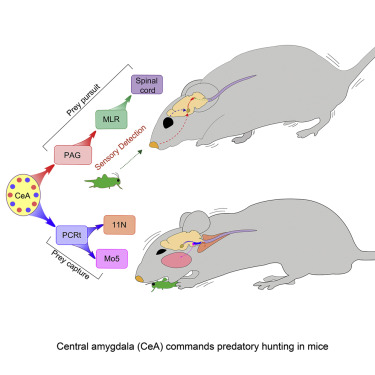|
|
Mapping the brain
Hunger switches on predatory brain instincts
Yale University researchers have isolated in the amygdala of the brain, the circuitry that coordinates hunting. The amygdala is known as the brains' center of emotion and motivation. Now, one of its group of neurons is identified as signaling an animal to pursue prey, a second group to bite with jaw and neck muscles to make the kill.
Predatory hunting is highly complex as well as common to most vertebrates with jaws, explains Ivan de Araujo, Associate Professor of Psychiatry at the Yale University School of Medicine and an Associate Fellow at the John B. Pierce Laboratory. "It is a major evolutionarily player in shaping the brain." As such, it must have existed from early mammalian beginnings originating in that part of our brain below the cerebral cortex.
De Araujo's study grew out his efforts to understand the neural mechanisms of feeding behavior in mice. After watching mice live and eat in cages, he thought: "They have nothing else to do other than eat pellets we throw in the cage. I began to wonder how natural and relevant is this behavior." His interest in natural behaviors led him to study brain maps of areas associated with hunting and feeding. Although many were listed, only one almost exlusively responded to hunting — but not to eating. The central nucleus of the amygdala has projections linked to brain areas controlling hunting muscles, such as in the jaw and neck. De Araujo: "This area is perfectly compatible with activating what drives motor behavior associated with hunting."
Using lasers, optogenetics, researchers flashed beams on specific neurons within a mouse brain and found that when the laser is off : animals behaved normally — when the laser is on: mice acted like characters from The Walking Dead, chasing and biting anything in their path, even bottle caps and wooden sticks.
"We'd turn the laser on and they'd jump on an object, hold it with their paws and intensively bite it as if they were trying to capture and kill it," says de Araujo. Animals did not, however, attack other mice in their cage. Hunger seemed the motivation toward predatory behavior.
Hungry mice aggressively pursued prey during laser stimulation — but not mice that were not hungry.
"The system is not generalized aggression. It seems related to an animal's interest in obtaining food."
Ivan de Araujo PhD, Associate Professor of Psychiatry at the Yale University School of Medicine and an Associate Fellow at the John B. Pierce Laboratory.
After specifically cutting each of the two neuron types, researchers were able to identify which of the two was associated with stalking and attack, and which with biting and killing. While one cut neuron group stopped the stalking behavior, the other decreased an animals' jaw biting force by 50 percent. De Araujo: "They fail to deliver the killing bite."
The team is now exploring sensory input into the amygdala. They want to determine what triggers predatory behaviors and investigate how of the two — one for pursuit, the other for the kill — are coordinated.
De Araujo's study appears in the January 12, 2017 issue of Cell
"We now have a grip on their anatomical identities, so we hope we can manipulate them even more precisely in the future."
Ivan de Araujo PhD.
Abstract Highlights
•Stimulation of central amygdala (CeA) elicited hunting of live and artificial prey
•CeA projections to the reticular formation (PCRt) control biting attacks
•CeA projections to periaqueductal gray (PAG) control locomotion during pursuit
•CeA integrates craniofacial and locomotor modules during goal-directed behavior
Summary
Superior predatory skills led to the evolutionary triumph of jawed vertebrates. However, the mechanisms by which the vertebrate brain controls predation remain largely unknown. Here, we reveal a critical role for the central nucleus of the amygdala in predatory hunting. Both optogenetic and chemogenetic stimulation of central amygdala of mice elicited predatory-like attacks upon both insect and artificial prey. Coordinated control of cervical and mandibular musculatures, which is necessary for accurately positioning lethal bites on prey, was mediated by a central amygdala projection to the reticular formation in the brainstem. In contrast, prey pursuit was mediated by projections to the midbrain periaqueductal gray matter. Targeted lesions to these two pathways separately disrupted biting attacks upon prey versus the initiation of prey pursuit. Our findings delineate a neural network that integrates distinct behavioral modules and suggest that central amygdala neurons instruct predatory hunting across jawed vertebrates.
Keywords:
central amygdala, craniofacial control, jaw, locomotion, motor control, periaqueductal grey, predation, predatory hunting, reticular formation
Cell, Han et al.: "Integrated Control of Predatory Hunting by the Central Nucleus of the Amygdala." http://www.cell.com/cell/fulltext/S0092-8674(16)31743-3
This work was supported by the National Institutes of Health, the National Natural Science Foundation of China, and the Brazilian government.
Cell (@CellCellPress), the flagship journal of Cell Press, is a bimonthly journal that publishes findings of unusual significance in any area of experimental biology, including but not limited to cell biology, molecular biology, neuroscience, immunology, virology and microbiology, cancer, human genetics, systems biology, signaling, and disease mechanisms and therapeutics. Visit: http://www.cell.com/cell. To receive Cell Press media alerts, contact press@cell.com.
Return to top of page
|
|
|
Jan 23, 2017 Fetal Timeline Maternal Timeline News News Archive
 Image Credit: Yale University School of Medicine
Image Credit: Yale University School of Medicine
|



